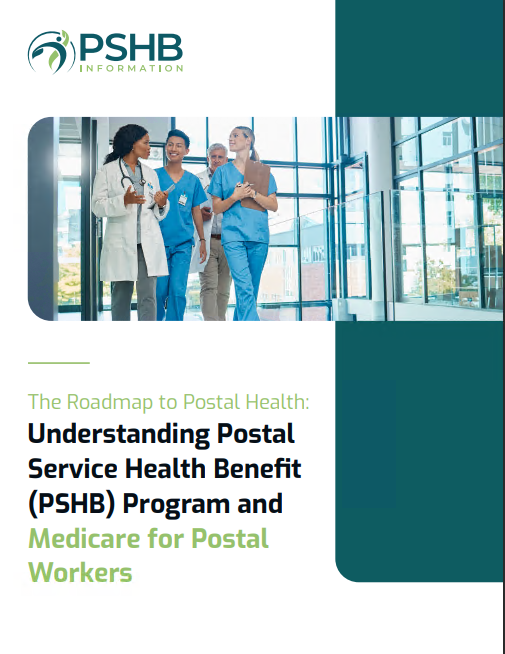Key Takeaways:
- The Postal Service Health Benefits (PSHB) program is set to replace the Federal Employees Health Benefits (FEHB) for postal retirees starting in 2025, and enrollment is crucial for maintaining coverage.
- Open Season for the PSHB runs from November 11, 2024, to December 9, 2024, offering a critical window to secure health coverage for retirement.
As a United States Postal Service (USPS) worker or retiree, planning your healthcare coverage as you approach retirement is crucial. The new Postal Service Health Benefits (PSHB) program is a major shift, set to launch on January 1, 2025. This change means postal employees and retirees need to understand how their health benefits will be impacted after they turn 65, especially regarding Medicare enrollment and coverage.
If you’re nearing retirement or currently retired, it’s essential to be aware of this transition to the PSHB and how it interacts with Medicare. This article covers what you need to know about the upcoming changes, important timelines, and how to stay covered after age 65.
What is the Postal Service Health Benefits Program (PSHB)?
The PSHB is a new health benefits program specifically for USPS workers and retirees. It replaces the Federal Employees Health Benefits (FEHB) plan that postal employees have used for years. The switch to PSHB is a result of the Postal Service Reform Act, which mandates a more tailored health benefits solution for postal workers.
This change is significant for future retirees, as they will no longer be automatically enrolled in FEHB. Instead, you’ll need to transition into the PSHB to maintain your health coverage during retirement. The launch date for this program is January 1, 2025.
How Does PSHB Work With Medicare?
If you’re approaching 65, it’s important to understand how the PSHB program integrates with Medicare. Retirees will be required to enroll in Medicare Part A (hospital insurance) and Part B (medical insurance) to complement their PSHB coverage. This shift is intended to provide comprehensive health care coverage, reducing out-of-pocket costs in the long run.
Medicare Part A is typically premium-free if you’ve worked and paid Medicare taxes for at least 10 years. Medicare Part B, however, comes with a monthly premium based on your income. Enrolling in both Medicare and the PSHB will ensure you have a robust coverage plan that includes both primary and secondary care services. The PSHB will act as a supplement to Medicare, meaning Medicare will become your primary insurance, and PSHB will cover what Medicare does not, such as copayments and deductibles.
Do I Need to Enroll in Medicare If I Have PSHB?
Yes, if you’re 65 or older, you will need to enroll in Medicare Part A and Part B to stay covered under the PSHB program. This is different from the FEHB program, where Medicare enrollment was optional. Under PSHB, failure to enroll in Medicare when eligible could result in losing your health coverage or paying higher out-of-pocket costs for healthcare services.
It’s important to enroll in Medicare when you first become eligible at age 65 to avoid any late enrollment penalties. The Initial Enrollment Period (IEP) for Medicare starts three months before your 65th birthday and ends three months after. During this period, you can sign up for both Medicare Part A and Part B without penalties.
How Does the PSHB Open Season Work?
The PSHB Open Season is the designated period when you can enroll, cancel, or make changes to your health benefits coverage for the upcoming year. For USPS workers and retirees, the PSHB Open Season for 2025 coverage runs from November 11, 2024, through December 9, 2024. During this window, you can select your PSHB plan that will take effect on January 1, 2025.
This is a critical window for both active employees and retirees. If you’re already retired or planning to retire soon, this is your opportunity to ensure you’re enrolled in the right health plan for your retirement needs.
What Happens if I Miss the PSHB Open Season?
Missing the PSHB Open Season can lead to complications with your healthcare coverage. If you’re already retired and fail to enroll during the Open Season, you might lose access to your health benefits for the year, leaving you without coverage or having to wait until the next Open Season to enroll. To avoid any gaps in coverage, it’s crucial to mark your calendar and complete your enrollment by the December 9, 2024 deadline.
If you’re still an active USPS employee, missing the Open Season could also delay your transition to PSHB when you retire. Take this time to evaluate your healthcare needs and make any necessary changes before the window closes.
What Should I Do Before the Open Season?
Before the Open Season begins on November 11, 2024, there are several important steps you should take to ensure a smooth transition:
-
Review Your Current Coverage: Take a close look at your current FEHB coverage and compare it with the available PSHB plans to determine what best fits your needs during retirement.
-
Enroll in Medicare: If you’re turning 65 soon or are already 65 and haven’t enrolled in Medicare, make sure you sign up for Medicare Parts A and B. This is a requirement for staying covered under the PSHB once you retire.
-
Evaluate Your Healthcare Needs: Consider any ongoing medical conditions, your budget for healthcare premiums, and out-of-pocket costs when selecting a PSHB plan. The PSHB options will vary, so it’s important to choose a plan that works best for your individual needs.
-
Plan for Future Costs: Although Medicare Part A is typically free, Medicare Part B does have a monthly premium. Be sure to budget for these costs when planning your retirement expenses.
How Does This Affect Current FEHB Enrollees?
If you’re already enrolled in the Federal Employees Health Benefits (FEHB) program, you’ll need to transition to the PSHB program when it becomes available. FEHB coverage will no longer be available for postal retirees starting in 2025, so the Open Season in 2024 is your opportunity to make the switch.
This transition is automatic for most USPS employees and retirees, but it’s important to ensure all paperwork and Medicare enrollment requirements are completed to avoid any gaps in coverage. The USPS will send you detailed information about the switch from FEHB to PSHB, including steps to complete your enrollment during Open Season.
What Happens After January 1, 2025?
After January 1, 2025, the PSHB program officially begins, and it will become the primary health benefits program for postal retirees. Medicare will be the primary payer for most services, while PSHB will cover additional costs, such as copayments and deductibles.
For those already enrolled in both Medicare and PSHB, this transition should be seamless, with both programs working together to provide comprehensive coverage. However, if you’re not yet enrolled in Medicare or PSHB, you may face higher out-of-pocket expenses or delays in receiving care.
Important Dates to Remember
- PSHB Open Season: November 11, 2024 – December 9, 2024
- PSHB Launch Date: January 1, 2025
- Medicare Initial Enrollment Period (IEP): Starts three months before your 65th birthday and ends three months after.
It’s essential to keep these dates in mind to avoid any disruptions to your health coverage. Be proactive about enrolling in Medicare and PSHB to ensure you continue receiving the care you need in retirement.
Prepare for the Transition to PSHB and Medicare
Understanding the upcoming changes to your health benefits can be overwhelming, but with careful planning and attention to deadlines, you can make a smooth transition. The shift from FEHB to PSHB and the required Medicare enrollment are major considerations for USPS retirees. As long as you enroll on time and select a plan that meets your needs, you’ll have the coverage you need to enjoy a healthy retirement.








